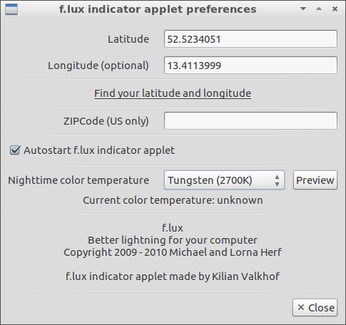Improve Your Night Sleep with Redshift and F.lux

Productivity Sauce
A bad night's sleep can affect your productivity like nothing else. And spending evenings in front of a bright computer screen does absolutely nothing to make you sleep better at night. The bright light emitted by the computer screen tricks your brain into thinking that it's still daytime -- not a good thing at 11 p.m. when your gray matter should be preparing itself for a good night's sleep.
Redshift and F.lux provide a simple fix for this problem. The utility adjusts the color temperature of the screen according to the time of the day at your specific geographical location. So as it's getting later (and darker) outside, the color temperature of your screen becomes warmer, making your brain (correctly) think that it's already evening.
Redshift is a command-line utility (although it does have a graphical front-end which can be installed separately), and its binary packages for popular Linux distros are available on the project's website. Users of Ubuntu-based distros will be pleased to learn that Redshift is also available in Ubuntu's official software repositories, so it can be installed using the sudo apt-get install redshift command. The utility accepts a handful of parameters, and you need to specify at least one: the latitude and longitude of your current location using the -l switch as in the example below ( you can use the Where Am I? page to quickly find your exact coordinates):
redshift -l 52.5:13.4
Usually this is enough to make Redshift do its job, but the utility sports other parameters you can tweak. Check the project's website for further info.
If you don't fancy Redshift, then you might want to give F.lux a try. A packaged version of the utility for Ubuntu is available in a separate PPA, and you can install F.lux on your machine using the following commands.
sudo add-apt-repository ppa:kilian/f.lux sudo apt-get update sudo apt-get install fluxgui
Once up and running, the utility adds an indicator applet. Click on it, and choose the Preferences item to configure the settings. All of the available options in the Preferences panel are self-explanatory, so you shouldn't have problems configuring F.lux.
Comments
comments powered by DisqusSubscribe to our Linux Newsletters
Find Linux and Open Source Jobs
Subscribe to our ADMIN Newsletters
Support Our Work
Linux Magazine content is made possible with support from readers like you. Please consider contributing when you’ve found an article to be beneficial.

News
-
System76 Releases COSMIC Alpha 7
With scores of bug fixes and a really cool workspaces feature, COSMIC is looking to soon migrate from alpha to beta.
-
OpenMandriva Lx 6.0 Available for Installation
The latest release of OpenMandriva has arrived with a new kernel, an updated Plasma desktop, and a server edition.
-
TrueNAS 25.04 Arrives with Thousands of Changes
One of the most popular Linux-based NAS solutions has rolled out the latest edition, based on Ubuntu 25.04.
-
Fedora 42 Available with Two New Spins
The latest release from the Fedora Project includes the usual updates, a new kernel, an official KDE Plasma spin, and a new System76 spin.
-
So Long, ArcoLinux
The ArcoLinux distribution is the latest Linux distribution to shut down.
-
What Open Source Pros Look for in a Job Role
Learn what professionals in technical and non-technical roles say is most important when seeking a new position.
-
Asahi Linux Runs into Issues with M4 Support
Due to Apple Silicon changes, the Asahi Linux project is at odds with adding support for the M4 chips.
-
Plasma 6.3.4 Now Available
Although not a major release, Plasma 6.3.4 does fix some bugs and offer a subtle change for the Plasma sidebar.
-
Linux Kernel 6.15 First Release Candidate Now Available
Linux Torvalds has announced that the release candidate for the final release of the Linux 6.15 series is now available.
-
Akamai Will Host kernel.org
The organization dedicated to cloud-based solutions has agreed to host kernel.org to deliver long-term stability for the development team.


Really cool.